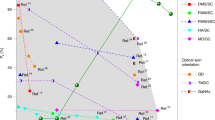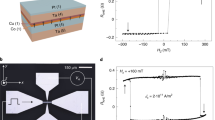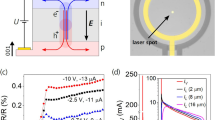Abstract
Recent studies of n-type semiconductors have demonstrated spin-coherent transport over macroscopic distances1, with spin-coherence times exceeding 100 ns2,3; such materials are therefore potentially useful building blocks for spin-polarized electronics (‘spintronics’). Spin injection into a semiconductor (a necessary step for spin electronics4) has proved difficult5,6; the only successful approach involves classical injection of spins from magnetic semiconductors7,8. Other work has shown that optical excitation can provide a short (<500 ps) non-equilibrium burst of coherent spin transfer across a GaAs/ZnSe interface, but less than 10% of the total spin crosses into the ZnSe layer, leaving long-lived spins trapped in the GaAs layer (ref. 9). Here we report a ‘persistent’ spin-conduction mode in biased semiconductor heterostructures, in which the sourcing of coherent spin transfer lasts at least 1–2 orders of magnitude longer than in unbiased structures. We use time-resolved Kerr spectroscopy to distinguish several parallel channels of interlayer spin-coherent injection. The relative increase in spin-coherent injection is up to 500% in the biased structures, and up to 4,000% when p–n junctions are used to impose a built-in bias. These experiments reveal promising opportunities for multifunctional spin electronic devices (such as spin transistors that combine memory and logic functions), in which the amplitude and phase of the net spin current are controlled by either electrical or magnetic fields.
This is a preview of subscription content, access via your institution
Access options
Subscribe to this journal
Receive 51 print issues and online access
$199.00 per year
only $3.90 per issue
Buy this article
- Purchase on Springer Link
- Instant access to full article PDF
Prices may be subject to local taxes which are calculated during checkout




Similar content being viewed by others
References
Kikkawa, J. M. & Awschalom, D. D. Lateral drag of spin coherence in gallium arsenide. Nature 397, 139–141 (1999).
Kikkawa, J. M., Smorchkova, I. P., Samarth, N. & Awschalom, D. D. Room-temperature spin memory in two-dimensional electron gases. Science 277, 1284–1287 (1997).
Kikkawa, J. M. & Awschalom, D. D. Resonant spin amplification in n-type GaAs. Phys. Rev. Lett. 80, 4313–4316 (1998).
Prinz, G. A. Spin polarized transport. Phys. Today 48, 58–63 (1995).
Monzon, F. G. & Roukes, M. L. Spin injection and the local hall effect in InAs quantum wells. J. Mag. Magn. Mater. 198, 632–635 (1999).
Filip, A. T., Hoving, B. H., Jedema, F. J. & van Wees, B. J. Experimental search for the electrical spin injection in a semiconductor. Phys. Rev. B 62, 9996–9999 (2000).
Fiederling, R. et al. Injection and detection of a spin-polarized current in a light-emitting diode. Nature 402, 787–790 (1999).
Ohno, Y. et al. Electrical spin injection in a ferromagnetic semiconductor heterostructure. Nature 402, 790–792 (1999).
Malajovich, I., Kikkawa, J. M., Awschalom, D. D., Berry, J. J. & Samarth, N. Coherent transfer of spin through a semiconductor heterointerface. Phys. Rev. Lett. 84, 1015–1018 (2000).
Yeganeh, M. S., Qi, J., Yodh, A. G. & Tamargo, M. C. Interface quantum well states observed by three-wave mixing in ZnSe/GaAs heterostructures. Phys. Rev. Lett. 68, 3761–3764 (1992).
Schull, K. et al. Non-metal in situ and ex situ ohmic contacts to a n-ZnSe. Semicond. Sci. Technol. 12, 485–489 (1997).
Malajovich, I., Kikkawa, J. M., Awschalom, D. D., Berry, J. J. & Samarth, N. Resonant amplification of spin transferred across a GaAs/ZnSe interface. J. Appl. Phys. 87, 5073–5075 (2000).
Acknowledgements
We thank M. E. Flatte, E. L. Hu, J. M. Kikkawa and H. Kroemer for discussions and suggestions. Work supported by DARPA, ARD, NSF and ONR.
Author information
Authors and Affiliations
Corresponding author
Rights and permissions
About this article
Cite this article
Malajovich, I., Berry, J., Samarth, N. et al. Persistent sourcing of coherent spins for multifunctional semiconductor spintronics. Nature 411, 770–772 (2001). https://doi.org/10.1038/35081014
Received:
Accepted:
Issue Date:
DOI: https://doi.org/10.1038/35081014
This article is cited by
-
Investigation of Ti doping on the structural, optical, and magnetic properties of ZnO nanoparticles
Journal of Materials Science: Materials in Electronics (2021)
-
Room-temperature polarized spin-photon interface based on a semiconductor nanodisk-in-nanopillar structure driven by few defects
Nature Communications (2018)
-
Study of structural, electronic, magnetic, and elastic properties of GaP and Ga0.75X0.25P (where X = Cr, Mn, and Fe) using DFT studies
Applied Physics A (2017)
-
Effect of Grain Size on Magnetic Properties of ZnO Doped with Nickel Single Impurities
Journal of Superconductivity and Novel Magnetism (2016)
-
Microstructural, crystallographic and optical characterizations of Cu-doped ZnO nanoparticles co-doped with Ni
Journal of Materials Science: Materials in Electronics (2015)
Comments
By submitting a comment you agree to abide by our Terms and Community Guidelines. If you find something abusive or that does not comply with our terms or guidelines please flag it as inappropriate.



